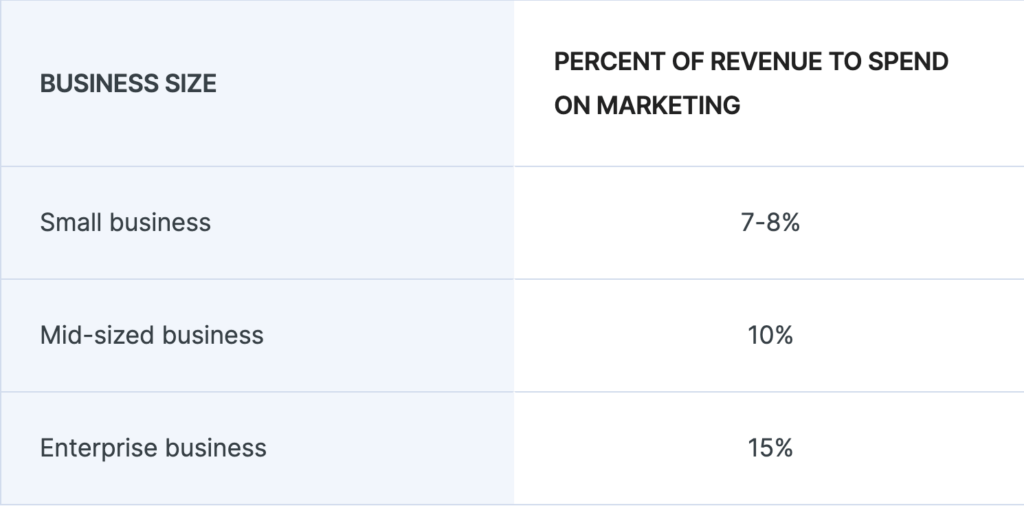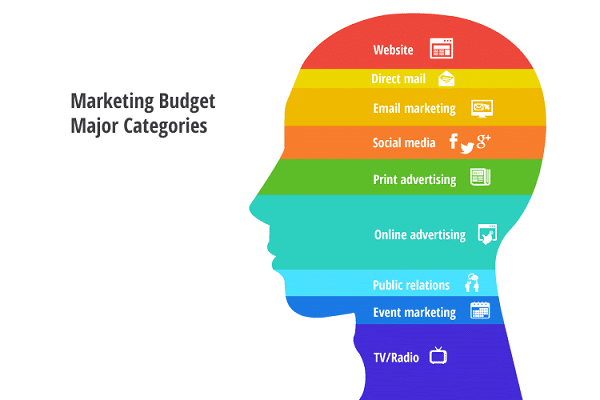
While there is no doubt that your company needs a marketing strategy and an accompanying budget to support it, determining the scope of that strategy and how much money to dedicate is challenging. Many business owners have heard about the 5% rule, which dictates that you should reinvest 5% of your revenue into marketing. While this is prudent advice, it is not a hard and fast rule. Many factors can and will determine your marketing budget. For example, you’ll likely have more budget constraints as a start-up business.
Once you have a figure, you’ll then decide how much money to allocate for marketing, what portion of those funds goes to traditional print and paid advertising, and how much goes to digital marketing.
Revising The Traditional 5% Revenue Rule
According to the U.S. Small Business Administration, businesses should spend 7 to 8 percent of gross revenue on marketing. That averages down to the generally accepted rule of spending about 5% of sales revenue on marketing. For example, if a company’s annual revenue is $2 million, then it would allot $100,000 to its marketing budget.
This is a rather conservative guideline, which often serves a company well. Consider, however, the importance of reinvesting more revenue back into your business through marketing. Depending on your organization’s goals, 5% may be too conservative. If you think along the lines of a marketing spectrum, 5% is the low end. Mid-range would be about 10%, and the high end comes in at about 15% and higher.
The amount of money you spend on marketing, particularly digital marketing, depends on a number of factors, such as the size and age of your business. Smaller businesses have specialized marketing goals compared to larger organizations. And, if yours is a new company, you likely have a much smaller budget than established companies in your industry.

So how much should you be spending?
Let’s break it down.
What’s Included in a Marketing Budget?
First, it’s essential to understand the elements included in a marketing budget. Most funds go toward direct marketing, which is anything related to selling and promoting a product or service. Within that category, costs are split among traditional and digital marketing efforts. Most of the time, most funds go to digital marketing focused on brand websites, social media, search engine marketing, email campaigns, and other online advertising.
Traditional marketing plays a role in the form of mail and magazine ads, billboards, and the like. However, the above online channels absorb over 50% of the average marketing budget. Regardless of the channel, developing a marketing strategy requires dedicated marketing research involving target audience analysis, trend forecasting, campaign testing, etc.
Factors that help determine your marketing needs, and thus the amount of your marketing budget, include your company’s age and history, industry, and marketing goals.
Start-Up Companies
When your company is new, you likely have limited funds. So, you’ll want to focus on what will bring you the most revenue. Digital marketing channels are the most effective and also the most cost-effective. If you can, target the mid-range of 10% of your target gross revenue stream. Your focus at this time is building brand awareness and attracting leads.
Digital marketing costs include such things as automation tools, analytical software, market research, and production costs. The costs, of course, vary depending on whether you’re using in-house staff, third-party vendors, or freelancers.
Other costs include those associated with branding (logos, business cards, swag, etc.) and content marketing. When it comes to digital marketing, having quality content is essential and worth the investment.
Marketing Needs Per Industry
Every industry operates differently and has different marketing needs. We can discuss generalities, though each niche within each industry contains its own unique requirements. Below are just some examples.
Software as a Service (SaaS) and Technology Companies
The marketing demand for SaaS is growing rapidly. Budgets are contingent upon the percentage the company can afford to reinvest in its marketing strategy. Because they don’t have high physical overhead costs, they can funnel more revenue into their digital marketing efforts, coming in at the high end of 25% or more.
Tech companies often have massive revenue streams and, like SaaS, lower overhead. They can also afford to reinvest more into marketing. Newer companies especially pour more into their marketing efforts to gain ground with their larger, well-established competitors. In fact, they will need to make substantial investments to promote growth as a new company.
Manufacturing
The manufacturing industry encompasses a broad range of fields, everything from food to healthcare to textiles. One thing they share is that none of them spend an overly large amount of money on marketing. They all tend to operate on the low end of the scale, spending 5% or less of total revenue on marketing.
Retail
Retail is a highly competitive industry, which makes marketing a high priority. Due to the competition, most retailers spend about 15% on marketing strategies, including traditional and digital marketing campaigns. Like other industries, however, the bulk of their efforts is on digital marketing like email, social media, and Search Engine Optimization (SEO).
Construction
While you may not think of marketing campaigns for construction companies, there is a need for targeted marketing, especially for newer companies. It is, after all, an effective way to gain a foothold in the industry. Marketing also directly connects to customer services and building trust with customers, both of which are critical to success in the construction field.
Thus, construction marketing is precisely targeted and requires a lower budget threshold. Companies can keep their marketing budget to the low end of 5% and be successful.
Communications and Media
While this industry may already have in-house staff who can handle their marketing needs, they still need a dedicated budget for it. Company goals focus on attracting high-profile clients. Therefore, they will need to invest a sizable amount into their marketing strategies to grow their business as well as highlight their specialized services.
These are just examples of some of the major industries. Whether any of these applies to you or your business falls into a different category, you’ll need to spend some time researching your industry’s marketing trends. You will even need to delve into your niche market within that industry to gain marketing insight.
Business Size
Naturally, the size of the business influences the marketing budget. The larger the company, the more money is available. The overall marketing percentage depends on a combination of your business’s size, scale, and growth stage. A startup may be small, but its marketing budget percentage may have to be high in order to establish the brand. The budget won’t likely decrease as the company grows, though it will be more proportionate to revenue streams. When it is more poised for growth, the marketing budget can increase once again.
Ultimately, your marketing budget needs to fit your business objectives and revenue. Once you’ve researched your industry in relation to marketing, that is, you’ll be able to determine an ideal budget based on your revenue. See what’s common in your industry and match it as best you can with the resources available to you.
If you find you’re limited, then set clear goals for achieving the desired results. These goals must be specific and measurable. For instance, if your goal is to increase website traffic, then by how much and by which fiscal quarter? Setting goals like these enables you to design your marketing campaigns and designate the appropriate funds.
Tips for Building Digital Marketing Strategy
Once you clearly understand your marketing needs and how much you want to spend overall, you can develop (or adjust) a comprehensive marketing strategy. The following are some general guidelines.
Set Your Marketing Goals
The first logical step toward marketing budget allocation is setting marketing goals, whether that be for the year or quarter by quarter. Some practical goals include the following:
- Increase Website Traffic. Whatever strategies you plan to implement should increase the number of visitors to your website per month. Along with that, you should see an increase in targeted leads to your website, which is measured by how many visits your site receives from people in your geographic service area. Finally, check this against your competition. Are you measuring up?
- Check Your Reporting Systems. You should have systems and processes in place to evaluate the effects of your advertising campaigns.
- Evaluate Your Brand. Even if your company has existed for a while, it’s always good practice to evaluate your brand and be sure you have a solidified brand image represented through all advertising channels. Ensure your brand is up-to-date and clearly and consistently identifies your brand image for consumers. It should have a distinct and consistent look across all media.
Identify and Address Potential Costs
Marketing is comprised of several components. All play a part, and it is up to you to determine which takes priority and receives the most funding. The categories are:
- Traditional Advertising. While digital advertising is more economical, traditional advertising still plays a part in most marketing strategies. Consider how much funding you want for radio and print ads, TV commercials, and print mailers.
- Company Website. Website costs include the original design, monthly hosting, and continuous updates. The content housed within your site should remain relevant and fresh. Whether you author your own content or hire freelancers, there is a cost associated with it. Additionally, you should build in the cost of analytics and the associated manpower and software that goes with it. Your website is the online face of your company, so its upkeep should be a high priority.
- Social Media Marketing. In addition to establishing your presence on social media through your company profiles, online advertising on social media platforms has proven results. You may want to allocate some funds for ads on Facebook and LinkedIn. That being said, even creating organic content has associated costs. Be sure you devote an appropriate amount to these efforts.
- Other Online Advertising. If you choose to advertise elsewhere online, such as Google Ads, plan for at least an average of $1,000 a month. That’s what’s required for ad campaigns to see any Return on Investment (ROI). As you learn what avenues work best, you can refine this number.
- Miscellaneous Advertising Expenses. Other costs you must account for include time and resources for email marketing, such as e-newsletters. If you incorporate video into any of your marketing platforms, additional time and cost are required to produce these. Finally, understand that you’ll need to train your staff to create and manage some or all the elements within your marketing plan.

Adjust Costs As You Go
As you implement your marketing budget, you will see where the higher costs lie. You’ll also see what you can afford and what items should receive less funds. If you keep up with your analytics, you’ll see what areas are performing well and which are not. Armed with this information, you can refine your marketing strategy and budget. Whether you decrease your costs or make better use of every dollar, you’ll strengthen your marketing ROI.
At a minimum, assess your marketing budget quarterly and then again annually. Review to ensure your initial budget projections remain aligned with your actual spending. Marketing costs can increase over time or in spurts. By monitoring performance and cost, you can refine as you go and eventually maintain an accurate, streamlined budget.
It’s not always about cutting costs. If you find that a particular area is yielding excellent results, you may want to increase funding there, with or without reducing costs in other areas. It may be well worth it to step outside of your 5% or 10% and into the higher area.
If you find that a significant overhaul is needed to stabilize your budget, then pause all day-to-day marketing activities until you refine your strategies. There’s no sense in continuing to spend money on ineffective campaigns.
What’s Your Magic Number?
Given all you know about your company, its marketing goals, and available funds, you may already have a budget. If you own a newer business, you may only have enough wiggle room for the minimum 5%. If your revenue is low, that doesn’t allow for much of a marketing budget.
However, digital marketing is inexpensive and highly effective. As your website gains more traffic and your revenue increases, be sure to funnel more money into your marketing budget. The ROI on marketing goes without saying. The challenge lies in channeling the right percentage of funds to the most effective marketing channels for your business. If you need help designing your marketing strategy, contact us and ask about our digital marketing services.